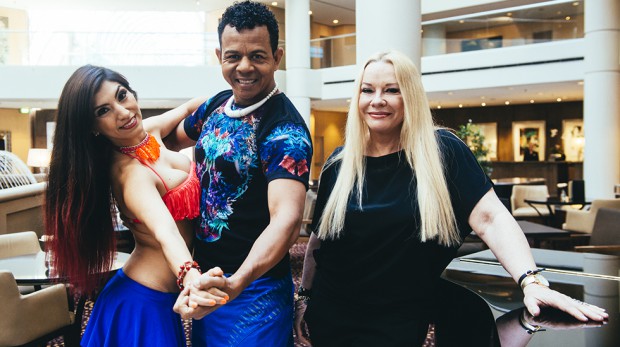
Running at the Regal Theatre from Thursday, October 23, until Saturday, November 2, Brazouka is a fabulous, furious fusion of Latin dance and music. To get the lowdown, we spoke to writer and lead producer Pamela Stephenson-Connolly.
What is Brazouka in a nutshell?
“It’s a dance show,” says Pamela Stephenson-Connolly, famed comedian and television presenter and, lest we forget, wife to the beloved Billy. “It’s a very commercial dance show. It’s very contemporary because Brazilians now, if you go to Sao Paulo, even Rio and you dance in a main central place like a club or something you’re going to be dancing to a Zouk remix of Ke$ha, Adele, Katy Perry even. Kind of more interesting than what you would imagine, it’s not so ethnic, not something that is a little bit alien.”
Zouk – specifically LambaZouk – is the key dance style used in the production. “It comes from Lambada. Lambada was very fashionable a few years ago and then it went out of fashion but of course everyone didn’t stop dancing it. In Brazil they started dancing it to Zouk music from the Caribbean, so LambaZouk reflects that. It’s turned into this dance – sensual but also incredibly playful, skilled, very athletic, very concerned with partner connection. There’s also a very cheeky way to dance it: if you’re dancing with a guy, you’ll be doing a turn and there will be another hand there and the guys kind of steal you from each other. They jump all over the dance floor and steal you and play. It’s just delicious.”
The show tells the story of lead dancer Braz Dos Santos, whose life was taken him from hard labour in a Brazilian fishing fleet to the world stage. “His story stood out, he had no educational opportunities, didn’t go to school because his family needed him to work as a child to make money for the family, so he still can’t read or write, but he was sent to sea, and after the fishing trips he would follow the older men back to the local bordello. He wasn’t allowed in but peeking through the window he saw the birth of Lambada. A lot of these dances started in bordellos – the tango started in bordellos – and the idea was to get the boys hot and so it wouldn’t take long – time was a premium. Eventually the dance became popular on the street, on the beaches, in the bars and he learned to dance. And one day he got tapped on the shoulder when he was dancing barefoot in this beach bar by this stranger who said, ‘Would you like to come to Paris and dance Lambada there?’ He didn’t know what Paris was!”
The show also has a strong supernatural theme running through it, dealing with the religions and folk beliefs of Brazil. “His father was a shaman in the Candomble religion, which is the religion the Africans brought to Portugal. So I’ve woven in all the stories of the orishas, the gods of Candomble, into the story. The story works on a lot of different layers.”
TRAVIS JOHNSON